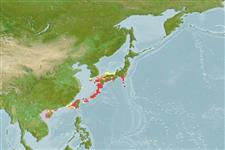>
Gobiiformes (Gobies) >
Gobiidae (Gobies) > Gobiinae
Etymology: Priolepis: Greek, prio = to saw + Greek,lepis = scale (Ref. 45335); latifascima: From the Latin lati, meaning broad, fasc, band, and ima, end, referring to the last bar on the head which is wider than the others; noun in apposition.
More on authors: Winterbottom & Burridge.
Environment: milieu / climate zone / rango de profundidad / distribution range
Ecología
marino asociado a arrecife; no migratorio; rango de profundidad 0 - 5 m (Ref. 9018). Subtropical
Northwest Pacific: restricted to Japan and Taiwan.
Tamaño / Peso / Age
Madurez: Lm ? range ? - ? cm
Max length : 2.1 cm SL macho / no sexado; (Ref. 9018)
Short description
Claves de identificación | Morfología | Morfometría
Espinas dorsales (total) : 7; Radios blandos dorsales (total) : 8; Espinas anales: 1; Radios blandos anales: 7. No frenum, reduced scalation, lacking scales on the breast and dorsally from the top of the pectoral fin base to end of the second dorsal fin base, the opercular and pectoral bar joining at a level with the eye, with the pectoral bar 1.5-2 times wider than the opercular bar, the first to fourth dorsal spines elongate, and eight dorsal-rays.
Body shape (shape guide): fusiform / normal.
Life cycle and mating behavior
Madurez | Reproducción | Puesta | Huevos | Fecundidad | Larva
Winterbottom, R. and M. Burridge, 1993. Revision of the species of Priolepis possessing a reduced transverse pattern of cheek papillae and no predorsal scales (Teleostei; Gobiidae). Can. J. Zool. 71:494-514. (Ref. 9018)
IUCN Red List Status (Ref. 130435: Version 2025-1)
Threat to humans
Harmless
Human uses
Herramientas
Special reports
Download XML
Fuentes de Internet
Estimates based on models
Preferred temperature (Referencia
123201): 21.4 - 26.6, mean 24.2 °C (based on 125 cells).
Phylogenetic diversity index (Referencia
82804): PD
50 = 0.5000 [Uniqueness, from 0.5 = low to 2.0 = high].
Bayesian length-weight: a=0.01023 (0.00477 - 0.02194), b=3.01 (2.83 - 3.19), in cm total length, based on LWR estimates for this (Sub)family-body shape (Ref.
93245).
Nivel trófico (Referencia
69278): 3.1 ±0.3 se; based on size and trophs of closest relatives
Resiliencia (Referencia
120179): Alto, población duplicada en un tiempo mínimo inferior a 15 meses (Preliminary K or Fecundity.).
Fishing Vulnerability (Ref.
59153): Low vulnerability (10 of 100).
🛈
